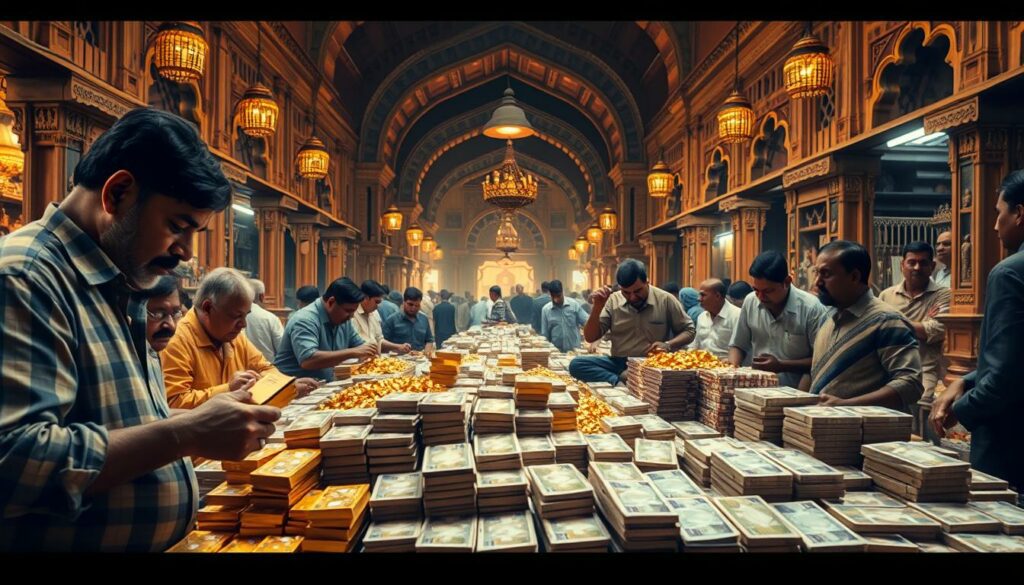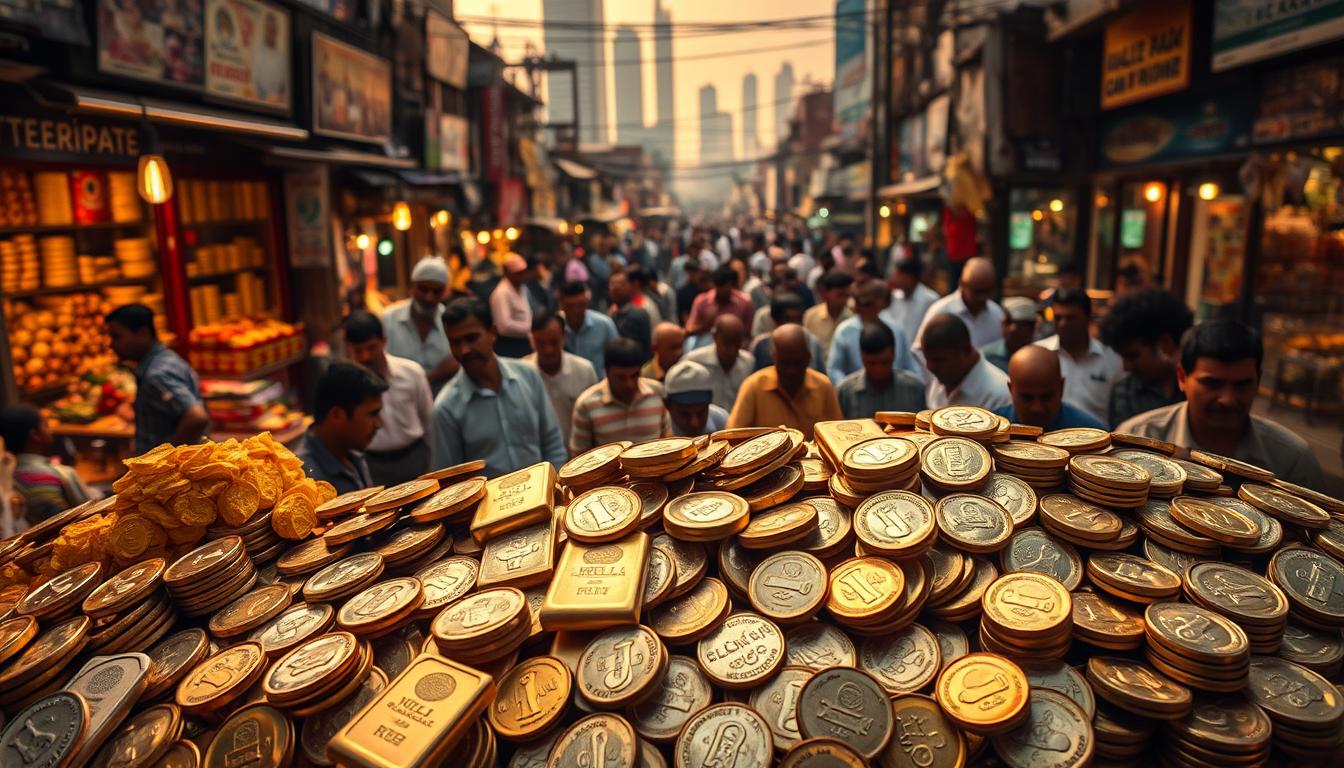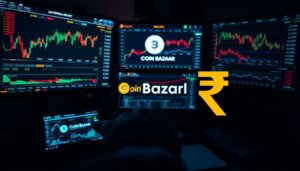India has a long history with precious metals, deeply rooted in its culture and economy. This relationship with precious metals goes back centuries, greatly influencing the precious metals market.
India is a key player in the global asian bullion trade. Its role goes beyond just consuming precious metals. It’s about shaping trade corridors that affect the whole region. India’s historical involvement in the bullion trade shows its lasting impact.
Key Takeaways
- India’s cultural and economic relationship with precious metals is historical and profound.
- The country’s influence on the precious metals market is substantial.
- India plays a crucial role in shaping the asian bullion trade corridors.
- The legacy of India’s involvement in the bullion trade continues to impact the region.
- Understanding India’s role is essential for grasping the dynamics of the global precious metals market.
The Historical Significance of Bullion in India
The story of bullion in India is filled with ancient trade and a deep love for gold. For ages, precious metals have been key to India’s economy and culture.
Ancient Trade Routes and Gold’s Cultural Importance
India’s location made it a center for ancient precious metals trade. The love for gold bars and other valuable items was not just for money. It was also because of cultural and religious reasons.
The Silk Road Connection to Bullion Movement
The Silk Road, a network of old trade paths, greatly affected bullion movement in India. This link helped trade and also brought cultural exchange between India and other lands.


It’s clear how ancient trade paths and gold’s cultural value have made India important in the global precious metals market.
Understanding the Asian Bullion Market Landscape
For investors, grasping the Asian bullion market is key. It’s a complex world with many players. These include investors, refineries, and exchanges.


Key Players in the Asian Precious Metals Ecosystem
The Asian precious metals scene is filled with diverse players. These are:
- Investors: Both individual and institutional investors drive demand for precious metals.
- Refineries: Major refineries are vital for producing and distributing bullion.
- Exchanges: Bullion exchanges are where trading happens, helping set prices.
These players work together, creating a dynamic and sometimes unpredictable market. For example, investor demand can shape trends. Meanwhile, refineries and exchanges provide the trading infrastructure.
Market Size and Growth Projections
The Asian bullion market has grown a lot lately. This growth is thanks to more investment in precious metals. Experts predict the market will keep growing, with demand likely to rise steadily.
Investment Trends Across Asian Markets
Investment patterns differ in various Asian markets. For instance:
- India is a big gold consumer, thanks to its cultural love for gold.
- China has also seen a lot of investment in precious metals, for both economic and investment reasons.
Knowing these trends is vital for investors in the Asian bullion market. As the market changes, keeping up with new trends and developments is crucial for smart investment choices.
India’s Position as a Global Bullion Consumption Hub
The demand for gold in India goes beyond just investment. It’s deeply tied to cultural and social practices. As one of the biggest gold consumers worldwide, India’s patterns offer key insights into the global bullion market.
Domestic Demand Patterns for Gold Bars and Coins
Several factors drive India’s demand for gold bars and coins. Gold bars are especially favored by investors seeking a solid asset. Coins, on the other hand, are bought for their beauty and symbolic value.
Cultural and Economic Drivers of Consumption
Cultural events like festivals and weddings boost gold demand in India. Gold is seen as a sign of prosperity and good luck. It’s a top choice for gifts during these times.
Festival and Wedding Season Impact on Bullion Demand
Festival and wedding seasons see a big jump in gold demand. This period, lasting several months, leads to a rise in gold purchases. This affects global bullion prices. Key festivals like Diwali and Akshaya Tritiya are especially important for gold sales.
- Diwali: Known as the festival of lights, it’s a peak time for gold buying.
- Akshaya Tritiya: Considered an auspicious day for buying gold, often resulting in a surge in demand.
- Wedding Season: The prolonged wedding season in India, especially in rural areas, contributes to sustained gold demand.
Understanding these cultural and economic drivers is key for those in the bullion market. They greatly shape India’s role as a global bullion consumption hub.
The Evolution of India’s Bullion Import Policies
Knowing the history of India’s bullion import policies is key for investors. These policies have changed due to economic, regulatory, and historical reasons.
Historical Regulatory Changes
India’s bullion import rules have been shaped by its foreign exchange and trade policies. The government has tweaked these rules to manage foreign exchange, control inflation, and protect local industries.
In the early 2000s, India let in gold and silver imports to meet demand. But, there were restrictions to control foreign exchange outflows. Over time, these rules have changed, getting more or less strict based on the economy.
Current Import Framework and Its Impact on Pricing
Today, bullion imports in India are controlled by the Reserve Bank of India (RBI) and the Ministry of Commerce. They decide how much bullion can be brought in, who can import it, and the duties and taxes involved.
How Policy Changes Affect Your Investment Decisions
Changes in bullion import policies can really affect gold and silver prices in India. For example, lower import duties can make prices drop, which is good for investing. But, higher duties or import limits can push prices up.
| Policy Change | Impact on Pricing | Investment Implication |
|---|---|---|
| Reduction in Import Duty | Prices Decrease | Favorable for Investment |
| Increase in Import Duty | Prices Increase | Less Favorable |
| Relaxation in Import Quotas | Potential Price Stabilization | Positive for Market Stability |
By grasping these changes, you can make better investment choices in the Indian bullion market.
India’s Gold Monetization Schemes
India is changing how people see gold as an investment with gold monetization schemes. These plans let you put your gold in banks and earn interest. It’s a new way to invest.
Structure and Implementation
The gold monetization scheme lets banks take gold deposits from people. They use this gold to lend to jewelry makers and other gold-using industries. Banks all over the country are part of this, making it easy for many to join.
How You Can Participate in Gold Schemes
To join gold monetization schemes, just put your gold in a bank. First, they check your gold’s purity and weight. Then, you get a special account that earns interest over time.
Benefits and Risks for Individual Investors
Investing in gold schemes has its perks. You can earn interest on your gold and keep it safe in a bank. But, there are downsides too. Gold prices and interest rates can change, affecting your investment.
| Benefits | Risks |
|---|---|
| Earn interest on gold holdings | Fluctuations in gold prices |
| Secure storage in banks | Interest rate changes |
| Diversified investment portfolio | Liquidity risks |
Knowing the good and bad about gold monetization schemes helps you make smart investment choices.
The Role of Indian Bullion Exchanges in Asian Markets
India’s bullion exchanges play a big role in the global precious metals market. They offer a strong and clear trading space. This is key for the bullion market to grow.
India International Bullion Exchange (IIBX)
The India International Bullion Exchange (IIBX) is a major player in India’s bullion trading. It has services and features for all market participants.
Trading Mechanisms and Accessibility
The IIBX has trading mechanisms for fast and safe deals. It’s easy for many to trade, from small investors to big companies.
The electronic trading platform shows prices in real-time. It helps trade different bullion products. This makes the market more liquid and stable.
Competitive Positioning Against Other Asian Exchanges
To see how IIBX stacks up, let’s compare it with other big Asian bullion exchanges:
| Exchange | Trading Volume | Products Offered |
|---|---|---|
| IIBX | High | Gold, Silver, Platinum |
| SGX | Very High | Gold, Silver, Platinum Futures |
| TOCOM | High | Gold, Silver, Platinum Futures |
IIBX stands out with its diverse product offerings and innovative trading mechanisms. As the Asian bullion market grows, Indian exchanges like IIBX will play a bigger role.
Asian Bullion Trade Corridors: India’s Strategic Importance
India plays a big role in the Asian bullion trade corridors. Its location makes it a key link between major bullion markets.
Major Trade Routes Connecting India to Asian Markets
India links to key Asian markets through several trade routes. These routes help move bullion smoothly, making India vital to regional trade.
Key trade routes include:
- The Middle East to India route, which is crucial for gold imports.
- The Southeast Asia route, which connects India to major silver-producing countries.
Infrastructure Development Supporting Bullion Movement
India is investing in infrastructure to boost bullion trade. It’s building top-notch ports and logistics facilities.
The importance of infrastructure is highlighted by:
“A well-developed infrastructure is crucial for the efficient movement of goods, including bullion.” – Industry Expert
The Dubai-Mumbai-Singapore Triangle
The Dubai-Mumbai-Singapore triangle is a key trade corridor. It helps move bullion between these major financial centers. This triangle is key in setting global prices for precious metals.
| City | Role in Bullion Trade |
|---|---|
| Dubai | Major gold trading hub |
| Mumbai | Key import and refining center |
| Singapore | Important financial and trading center |
India’s role in the Asian bullion trade corridors is strengthened by its spot in this triangle. It makes India a crucial player in the global precious metals market.
Digital Transformation in India’s Bullion Trade
Digital transformation is changing the Indian bullion trade in big ways. Technology is making trading platforms better and blockchain is adding security and transparency. These changes are making a big impact.
Technology Adoption in Trading Platforms
The Indian bullion trade is moving to digital platforms. These platforms make trading faster, cheaper, and more open. Online trading platforms let investors buy and sell bullion from home, making it easier to access.
Blockchain Applications for Transparency and Security
Blockchain is being used more in the bullion trade for its security and transparency. It creates a permanent record of transactions, stopping fraud and proving bullion’s authenticity. Blockchain-based systems also track bullion in real-time, from start to finish.
How Digital Solutions Benefit Your Bullion Investments
Digital solutions bring many benefits to bullion investments, including:
- Increased transparency and security
- Improved efficiency in transactions
- Real-time tracking and monitoring
- Enhanced accessibility for investors
The table below shows the main advantages of digital transformation in the Indian bullion trade:
| Benefit | Description |
|---|---|
| Increased Transparency | Digital platforms and blockchain ensure that all transactions are transparent and tamper-proof. |
| Improved Efficiency | Automated processes reduce transaction times and costs. |
| Enhanced Security | Blockchain technology ensures the authenticity and security of bullion. |
As the Indian bullion trade grows, digital transformation will become even more key. By using digital solutions, investors get a market that’s more efficient, secure, and open.
How to Buy Bullion Online in India’s Evolving Market
Buying bullion online in India is getting more popular. This is thanks to trusted digital platforms. It’s important to know how to buy precious metals online.
Trusted Platforms for Purchasing Precious Metals
Many online platforms let you buy bullion safely. They work with well-known refineries and mints. This ensures the quality of what you buy. When choosing a platform, look for:
- Authentication: Make sure the platform offers real products with verifiable hallmarks.
- Transparency: The platform should clearly show product details, prices, and any fees.
- Customer Support: Good customer service is key for answering questions or solving problems.
Verification and Authentication Processes
Good platforms have strong verification and authentication steps. This includes:
- Hallmarking: Products are marked with recognized hallmarks to prove purity.
- Serial Numbering: Some platforms give serial numbers for each product, making it easier to track.
- Certification: Look for certifications from trusted assaying offices.
Comparing Prices and Premium Structures
When buying bullion online, compare prices on different platforms. Look at the premium over the spot price, as it can differ a lot. Some platforms might offer better prices, while others might charge more for extra services like secure storage.
Delivery Options and Considerations
Delivery options can range from insured shipping to storage in secure vaults. Think about:
- Shipping Costs: Check if the platform offers free shipping or if there are extra costs.
- Storage Options: Some platforms offer vault storage, a safe way to keep your bullion.
Understanding these points helps you make smart choices when buying bullion online in India’s changing market.
Secure Storage Options for Your Precious Metals
After deciding to invest in precious metals, the next step is to find a safe place to store them. It’s key to know the different secure storage options in India.
Vaulting Infrastructure Development Across India
India has greatly improved its vaulting infrastructure. This gives investors strong and safe storage choices. Private vaulting services are now a top pick, with top-notch security and insurance. These vaults keep your metals safe from theft, loss, or damage.
Bank Lockers vs. Private Vaulting Services
You have two main choices for storing your metals: bank lockers or private vaults. Bank lockers are traditional and reliable but might be pricey and limited. Private vaults, however, offer more flexibility, better security, and often lower costs.
Insurance Considerations for Bullion Storage
Insurance is vital, whether you pick a bank locker or a private vault. Make sure your storage has full insurance for your metals against loss, theft, or damage.
Choosing the right storage and making sure it’s insured well will give you peace of mind. You’ll know your investments are in good hands.
- Check the storage’s security features.
- Look at the insurance options and costs.
- See how reliable and reputable the service is.
Silver Coins and Platinum Bullion: India’s Growing Alternative Markets
Silver coins and platinum bullion are making their mark in India’s precious metals scene. They offer investors fresh chances to grow their wealth. It’s key to grasp the ins and outs of these metals to make smart choices.
Silver Trade Dynamics and Investment Potential
The silver market in India is big, driven by demand for industrial use, jewelry, and investment. Silver coins are especially sought after by investors who want something real. Silver’s value is high because it’s used in many fields and helps protect against inflation.
Investors can profit from silver’s fluctuating prices by buying at the right time. Silver’s importance in Indian culture and ceremonies also keeps demand steady. This makes it a solid choice for the long haul.
Emerging Platinum and Palladium Markets
Platinum and palladium are becoming big names in India’s precious metals world. Platinum bullion is especially popular because it’s rare and used in cars for pollution control.
Diversification Strategies for Your Precious Metals Portfolio
Adding platinum and palladium to your portfolio can help reduce risk. By spreading your investment across different metals, you can protect your wealth from market ups and downs.
- Check your current portfolio to see where platinum and palladium fit best.
- Look at market trends and forecasts to guide your decisions.
- Look into different investment options like coins, bars, and ETFs to match your strategy.
By adding silver coins, platinum bullion, and other metals to your portfolio, you can make it more balanced. This approach can help you achieve a more stable investment strategy.
Regulatory Challenges and Opportunities in the Precious Metals Market
India’s precious metals market is growing fast. But, it faces many regulatory challenges. These include customs and taxation issues, policy reforms, and changing trade rules.
Customs and Taxation Issues Affecting Traders
Traders in the precious metals market struggle with customs duties and taxes. For example, high import duties on gold and silver can raise their prices in India.
| Metal | Import Duty | Impact on Pricing |
|---|---|---|
| Gold | 12.5% | High import duty increases domestic prices |
| Silver | 10% | Moderate impact on pricing due to lower duty |
Policy Reforms Shaping Future Trade
Policy reforms are key to India’s precious metals trade future. New rules aimed at making things easier have been welcomed by the industry.
“The government’s efforts to streamline regulations and reduce compliance burdens are expected to boost the competitiveness of India’s precious metals market.”
GST Impact on Bullion Transactions
The Goods and Services Tax (GST) has changed bullion transactions a lot. GST has made taxes simpler but added new rules for traders.
In conclusion, India’s precious metals market is facing tough rules. But, with new policies and tax changes, there’s room for growth and improvement.
Environmental and Ethical Considerations in India’s Bullion Trade
The Indian bullion market is growing fast. This means we need sustainable mining practices and ethical sourcing initiatives more than ever. As demand for precious metals increases, it’s vital to ensure the trade is green and fair.
Sustainable Mining Practices
Sustainable mining is key to reducing the bullion trade’s environmental impact. It involves using new tech to cut waste, saving water, and fixing mined areas. Responsible mining companies aim to lessen their environmental harm while staying profitable.
Ethical Sourcing Initiatives and Certifications
Ethical sourcing is also crucial in the bullion trade. Programs like the Responsible Minerals Initiative help companies source ethically and without conflict. The Fairmined label shows products meet high environmental and social standards.
How to Identify Responsibly Sourced Bullion
To find responsibly sourced bullion, look for certifications and clear supply chain info. Companies should share their sourcing and environmental policies openly. Also, check if they’re part of ethical sourcing groups.
| Certification | Description | Benefits |
|---|---|---|
| Fairmined | Ensures gold is mined in a responsible and sustainable manner. | Promotes fair labor practices and environmental stewardship. |
| Responsible Minerals Initiative | Provides a framework for responsible mineral sourcing. | Helps companies identify and mitigate risks in their supply chains. |
Choosing responsibly sourced bullion supports better, greener practices in the industry.
Investment Opportunities in Indian Precious Metals
The Indian precious metals market offers many investment options. It caters to different investor tastes. As gold and other precious metals’ demand rises, investors seek various ways to enter this market.
Physical vs. Paper Gold: What’s Right for You
Investors can choose between physical gold and paper gold. Physical gold is tangible, like bars and coins. On the other hand, paper gold includes financial products that follow gold prices without needing physical gold. It offers liquidity and easy transactions.
| Investment Type | Liquidity | Risk Level |
|---|---|---|
| Physical Gold | Medium | Low |
| ETFs | High | Medium |
| Sovereign Gold Bonds | Low | Low |
| Digital Gold | High | Medium |
ETFs, Sovereign Gold Bonds, and Digital Gold
ETFs and Sovereign Gold Bonds let investors profit from gold without physical gold. Digital gold platforms also offer a way to invest in gold. They provide flexibility and security.
Risk Assessment for Different Investment Vehicles
Each investment has its own risk level. For example, physical gold faces storage risks. Meanwhile, ETFs and digital gold deal with market volatility. Knowing these risks helps in making smart investment choices.
Conclusion: India’s Continuing Influence on Asian Bullion Trade
India’s culture, economy, and rules keep shaping the Asian bullion trade. It makes India a major player in the area. This article has shown how India’s influence is wide-ranging.
Its strategic spot, growing infrastructure, and digital changes make it a top spot for bullion trade. India’s role in the Asian bullion trade will keep growing. This is because of more demand for precious metals and the government’s support for the industry.
India’s impact on the Asian bullion trade will stay strong. Its love for gold makes it a key market. Investors and traders should keep an eye on India.














